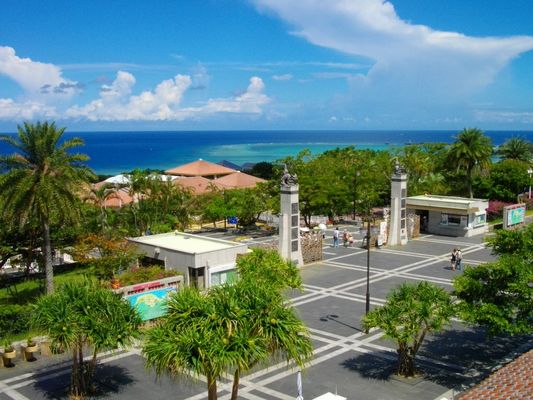A subtropical island with white-sand beaches and coral reefs. Home to unique Ryukyuan culture, karate, and longevity-promoting cuisine. Known for WWII history.
Okinawa Island, the largest in Japan's southernmost prefecture, is known for its turquoise waters and white sand beaches. This island in the East China Sea has a rich history as the center of the Ryukyu Kingdom, evident in sites like Shuri Castle. You can explore sacred groves like Sefa Utaki, snorkel in coral reefs, or try local dishes such as goya champuru. Okinawa's subtropical climate and relaxed atmosphere contribute to the long life expectancy of its residents.
Climate and Geography
Okinawa Island is located in the East China Sea, approximately 640 kilometers (400 miles) south of mainland Japan. The subtropical climate keeps temperatures warm throughout the year. The island is about 110 kilometers (68 miles) long and varies from 3 to 30 kilometers (2 to 19 miles) wide, with an extensive coastline.
Beaches and Marine Life
Okinawa's coast has many beaches with different characteristics. At Manza Beach, you'll find white sand and clear waters suitable for snorkeling. Zanpa Beach is known among surfers for its waves. The coral reefs around the island are home to tropical fish, sea turtles, and manta rays, making them good spots for diving.
Local Cuisine
Okinawan food differs from that of mainland Japan due to its history and climate. Try goya champuru, a stir-fry with bitter melon, tofu, and often spam - a result of American military presence. Okinawa soba uses wheat noodles in a pork-based broth, despite its name. For dessert, you might like chinsuko, a shortbread cookie often bought as a souvenir.
Natural Areas
The Yanbaru region in northern Okinawa has forests where you can spot rare wildlife like the Okinawa rail, a bird that can't fly and is only found here. You can walk to Hiji Waterfall for a swim or explore Gyokusendo Cave's limestone formations at Okinawa World theme park. Glass-bottom boat tours let you see sea turtles, fish, and coral without getting in the water.
Ryukyu Kingdom History
Okinawa was once the center of the Ryukyu Kingdom, which influenced its culture and buildings. Shuri Castle, a UNESCO World Heritage site, shows the architectural style from this period. A fire in 2019 damaged the main buildings, but you can still visit the grounds while reconstruction is ongoing. Sefa Utaki, a sacred grove, was an important site in traditional Okinawan religion.
Transportation
Renting a car is often practical for exploring Okinawa. The Okinawa Expressway connects Naha in the south to Nago in the north. If you prefer public transport, the Yui Rail monorail serves Naha and nearby areas, and buses run to other parts of the island.
Local Events
Okinawa hosts several events throughout the year. In October, you can watch or participate in the Naha Tug-of-War Festival, which uses a massive rope and has a Guinness World Record. The Nago Cherry Blossom Festival in January and February celebrates the early blooming of Okinawa's cherry trees, months before they bloom in the rest of Japan.











![An overview of Hiroshima, Japan, and the Hiroshima Memorial Peace Park - commemorating the 1945 atomic bombing of the city - as seen from a hotel rooftop on April 11, 2016, as U.S. Secretary of State John Kerry visited the city to attend the G7 Ministerial Meetings. [State Department photo/ Public Domain] | Hiroshima in Japan](https://humbo.s3.eu-north-1.amazonaws.com/place-photo/5ff8b36b9a7cce494339cc9b/ldnAp_Ep6I_thumb.jpeg)







